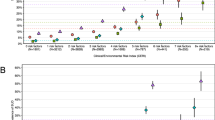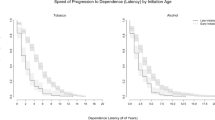Abstract
Multiple studies have provided evidence for genetic associations between single nucleotide polymorphisms (SNPs) located on the CHRNA5/A3/B4 gene cluster and various phenotypes related to Nicotine Dependence (Greenbaum et al. 2009). Only a few studies have investigated other substances of abuse. The current study has two aims, (1) to extend previous findings by focusing on associations between the CHRNA5/A3/B4 gene cluster and age of initiation of several different substances, and (2) to investigate heterogeneity in age of initiation across the different substances. All analyses were conducted with a subset of the Add Health study with available genetic data. The first aim was met by modeling onset of tobacco, alcohol, cannabis, inhalants, and other substance use using survival mixture analysis (SMA). Ten SNPs in CHRNA5/A3/B4 were used to predict phenotypic differences in the risk of onset, and differences between users and non-users. The survival models aim at investigating differences in the risk of initiation across the 5–18 age range for each phenotype separately. Significant or marginally significant genetic effects were found for all phenotypes. The genetic effects were mainly related to the risk of initiation and to a lesser extent to discriminating between users and non-users. To address the second goal, the survival analyses were complemented by a latent class analysis that modeled all phenotypes jointly. One of the ten SNPs was found to predict differences between the early and late onset classes. Taken together, our study provides evidence for a general role of the CHRNA5/A3/B4 gene cluster in substance use initiation that is not limited to nicotine and alcohol.

Similar content being viewed by others
References
Amos CI, Wu X, Broderick P, Gorlov IP, Gu J, Eisen T, Dong Q, Zhang Q, Gu X, Vijayakrishnan J, Sullivan K, Matakidou A, Wang Y, Mills G, Doheny K, Tsai YY, Chen WV, Shete S, Spitz MR, Houlston RS (2008) Genomewide association scan of tag SNPs identifies a susceptibility locus for lung cancer at 15q25.1. Nature Genetics 40:616–622. doi:10.1038/ng.109
Bierut LJ, Stitzel JA, Wang JC, Hinrichs AL, Grucza RA, Xuei X, Saccone NL, Saccone SF, Bertelsen S, Fox L, Horton WJ, Breslau N, Budde J, Cloninger CR, Dick DM, Foroud T, Hatsukami D, Hesselbrock V, Johnson EO, Kramer J, Kuperman S, Madden PA, Mayo K, Nurnberger J Jr, Pomerleau O, Porjesz B, Reyes O, Schuckit M, Swan G, Tischfield JA, Edenberg HJ, Rice JP, Goate AM (2008) Variants in nicotinic receptors and risk for nicotine dependence. Am J Psychiatry 165:1163–1171
Chatterjee S, Bartlett SE (2010) Neuronal nicotinic acetylcholine receptors as pharmacotherapeutic targets for the treatment of alcohol use disorders. CNS Neurol Disord Drug Targets 9(1):60–76 Review. PubMed PMID: 20201817
Chen X, Chen J, Williamson VS, An SS, Hettema JM, Aggen SH et al (2009) Variants in nicotinic acetylcholine receptors alpha5 and alpha3 increase risks to nicotine dependence. Am J Med Genet B Neuropsychiatr Genet (e-pub ahead of print)
Cheverud JM (2001) A simple correction for multiple comparisons in interval mapping genome scans. Heredity 87:52–58
De Biasi M, Salas R (2008) Influence of neuronal nicotinic receptors over nicotine addiction and withdrawal. Exp Biol Med (Maywood) 233(8):917–929
Duncan LE, Keller MC (2011) A critical review of the first 10 years of candidate gene-by-environment interaction research in psychiatry. Am J Psychiatry 168(10):1041–1049
Fryer JD, Lukas RJ (1999) Noncompetitive functional inhibition at diverse, human nicotinic acetylcholine receptor subtypes by bupropion, phencyclidine, and ibogaine. J Pharmacol Exp Ther 288(1):88–92
Gillespie NA, Lubke GH, Gardner CO, Neale MC, Kendler KS (2011) Two-part random effects growth modeling to identify risks associated with alcohol and cannabis initiation, initial average use and changes in drug consumption in a sample of adult, male twins. Drug Alcohol Depend (Epub ahead of print)
Glick SD, Maisonneuve IM et al (2001) Mechanisms of action of ibogaine: relevance to putative therapeutic effects and development of a safer iboga alkaloid congener. Alkaloids Chem Biol 56:39–53
Gotti C, Clementi F, Fornari A, Gaimarri A, Guiducci S, Manfredi I, Moretti M, Pedrazzi P, Pucci L, Zoli M (2009) Structural and functional diversity of native brain neuronal nicotinic receptors. Biochem Pharmacol 78(7):703–711
Greenbaum L, Lerer B (2009) Differential contribution of genetic variation in multiple brain nicotinic cholinergic receptors to nicotine dependence: recent progress and emerging open questions. Mol Psychiatry 14:912–945
Greenbaum L, Rigbi A, Teltsh O, Lerer B (2009) Role of genetic variants in the CHRNA5-CHRNA3-CHRNB4 cluster in nicotine dependence risk: importance of gene-environment interplay. Mol Psychiatry 14:828–830
Harris KM (2009) The National Longitudinal Study of Adolescent Health (Add Health), Waves I & II, 1994–1996; Wave III, 2001–2002; Wave IV, 2007–2009 [machine-readable data file and documentation]. Carolina Population Center, University of North Carolina, Chapel Hill
Harris KM, Halpern CT, Smolen A, Haberstick BC (2006) The national longitudinal study of adolescent health (Add Health) twin data. Twin Res Hum Gen 9:977–988
Li J, Ji L (2005) Adjusting multiple testing in multilocus analyses using the eigenvalues of a correlation matrix. Heredity 95:221–227
Lubke GH (2010) Latent variable mixture modeling. In: Hancock GR, Mueller RO (eds) The reviewer’s guide to quantitative methods in the social sciences. Routledge, New York, pp 283–297
Lubke GH, Neale MC (2006) Distinguishing between latent classes and continuous factors: resolution by maximum likelihood? Multivar Behav Res 41:499–532
Lubke GH, Neale MC (2008) Distinguishing between latent classes and continuous factors with categorical outcomes: class invariance of parameters of factor mixture models. Multivar Behav Res 43:592–620
Maisonneuve IM, Glick SD (2003) Anti-addictive actions of an iboga alkaloid congener: a novel mechanism for a novel treatment. Pharmacol Biochem Behav 75(3):607–618
Mansvelder HD, Fagen ZM et al (2007) Bupropion inhibits the cellular effects of nicotine in the ventral tegmental area. Biochem Pharmacol 74(8):1283–1291
Mihalak KB, Carroll FI et al (2006) Varenicline is a partial agonist at alpha4beta2 and a full agonist at alpha7 neuronal nicotinic receptors. Mol Pharmacol 70(3):801–805
Muthén B, Masyn K (2005) Discrete-time survival mixture analysis. J Educational Behavioral Stat 30:27–28
Muthén LK, Muthén BO (1998/2010) Mplus User’s Guide 6th edn. Los Angeles, CA: Muthén and Muthén
Nyholt DR (2004) A simple correction for multiple testing for single-nucleotide polymorphisms in linkage disequilibrium with each other. Am J Hum Genet 74:765–769
Nylund KL, Asparouhov T, Muthen B (2007) Deciding on the number of classes in latent class analysis and growth mixture modeling. A Monte Carlo simulation study. Struct Equ Model 14:535–569
Saccone NL, Wang JC, Breslau N, Johnson EO, Hatsukami D, Saccone SF, Grucza RA, Sun L, Duan W, Budde J et al (2009a) The CHRNA5-CHRNA3-CHRNB4 nicotinic receptor subunit gene cluster affects risk for nicotine dependence in African–Americans and in European–Americans. Cancer Res 69:6848–6856
Saccone NL, Saccone SF, Hinrichs AL, Stitzel JA, Duan W, Pergadia ML, Agrawal A, Breslau N, Grucza RA, Hatsukami D, Johnson EO, Madden PA, Swan GE, Wang JC, Goate AM, Rice JP, Bierut LJ (2009b) Multiple distinct risk loci for nicotine dependence identified by dense coverage of the complete family of nicotinic receptor subunit (CHRN) genes. Am J Med Genet B Neuropsychiatr Genet 150B(4):453–466
Saccone NL, Culverhouse RC, Schwantes-An TH, Cannon DS, Chen X, Cichon S, Giegling I, Han S, Han Y, Keskitalo-Vuokko K, Kong X, Landi MT, Ma JZ, Short SE, Stephens SH, Stevens VL, Sun L, Wang Y, Wenzlaff AS, Aggen SH, Breslau N, Broderick P, Chatterjee N, Chen J, Heath AC, Heliövaara M, Hoft NR, Hunter DJ, Jensen MK, Martin NG, Montgomery GW, Niu T, Payne TJ, Peltonen L, Pergadia ML, Rice JP, Sherva R, Spitz MR, Sun J, Wang JC, Weiss RB, Wheeler W, Witt SH, Yang BZ, Caporaso NE, Ehringer MA, Eisen T, Gapstur SM, Gelernter J, Houlston R, Kaprio J, Kendler KS, Kraft P, Leppert MF, Li MD, Madden PA, Nöthen MM, Pillai S, Rietschel M, Rujescu D, Schwartz A, Amos CI, Bierut LJ (2010) Multiple independent loci at chromosome 15q25.1 affect smoking quantity: a meta-analysis and comparison with lung cancer and COPD. PLoS Genet 6(8):e1001053
Salas R, Cook KD et al (2004a) The alpha3 and beta4 nicotinic acetylcholine receptor subunits are necessary for nicotine-induced seizures and hypolocomotion in mice. Neuropharmacology 47(3):401–407
Salas R, Pieri F et al (2004b) Decreased signs of nicotine withdrawal in mice null for the beta4 nicotinic acetylcholine receptor subunit. J Neurosci 24(45):10035–10039
Schlaepfer IR, Hoft NR, Ehringer MA (2008a) The genetic components of alcohol and nicotine co-addiction: from genes to behavior. Curr Drug Abuse Rev 2008(1):124–134
Schlaepfer IR, Hoft NR, Collins AC, Corley RP, Hewitt JK, Hopfer CJ, Lessem JM, McQueen MB, Rhee SH, Ehringer MA (2008b) The CHRNA5/A3/B4 gene cluster variability as an important determinant of early alcohol and tobacco initiation in young adults. Biol Psychiatry 63:1039–1046
Sherva R, Rice JP, Neuman RJ, Rochberg N, Saccone NL, Bierut LJ (2009) Associations and interactions between SNPs in the alcohol metabolizing genes and alcoholism phenotypes in European Americans. Alcohol Clin Exp Res 33:848–857
Sherva R, Kranzler HR, Yu Y, Logue MW, Poling J, Arias AJ, Anton RF, Oslin D, Farrer LA, Gelernter J (2010) Variation in nicotinic acetylcholine receptor genes is associated with multiple substance dependence phenotypes. Neuropsychopharmacology 35:1921–1931
Slemmer JE, Martin BR et al (2000) Bupropion is a nicotinic antagonist. J Pharmacol Exp Ther 295(1):321–327
Stephens SH, Hoft NR, Schlaepfer IR, Young SE, Corley RC, McQueen MB, Hopfer C, Crowley T, Stallings M, Hewitt J, Ehringer MA (2011) Externalizing behaviors are associated with SNPs in the CHRNA5/CHRNA3/CHRNB4 gene cluster. Behav Genet. PMID 22042234
Stevens VL, Bierut LJ, Talbot JT, Wang JC, Sun J, Hinrichs AL et al (2008) Nicotinic receptor gene variants influence susceptibility to heavy smoking. Cancer Epidemiol Biomarkers Prev 17:3517–3525
Thorgeirsson TE, Geller F, Sulem P, Rafnar T, Wiste A, Magnusson KP, Manolescu A, Thorleifsson G, Stefansson H, Ingason A et al (2008) A variant associated with nicotine dependence, lung cancer and peripheral arterial disease. Nature 452:638–642
Thorgeirsson TE, Gudbjartsson DF, Surakka I, Vink JM, Amin N, Geller F, Sulem P, Rafnar T, Esko T, Walter S et al; ENGAGE Consortium (2010) Sequence variants at CHRNB3-CHRNA6 and CYP2A6 affect smoking behavior. Nat Genet 42:448–453
Vermunt JK (1996) Log-linear event history analysis: a general approach with missing data, unobserved heterogeneity, and latent variables. Tilburg University Press, Tilburg
Weiss RB, Baker TB, Cannon DS, von Niederhausern A, Dunn DM, Matsunami N et al (2008) A candidate gene approach identifies the CHRNA5-A3-B4 region as a risk factor for age-dependent nicotine addiction. PLoS Genet 4:e1000125
Acknowledgments
The research of the first author was supported through grant DA018673 by NIDA. ME was supported by AA015336, AA107889, DA026901. SHS was supported by AA007464. JKH and JML were supported by HD031921. This research uses data from Add Health, a program project directed by Kathleen Mullan Harris and designed by J. Richard Udry, Peter S. Bearman, and Kathleen Mullan Harris at the University of North Carolina at Chapel Hill, and funded by grant P01-HD31921 from the Eunice Kennedy Shriver National Institute of Child Health and Human Development, with cooperative funding from 23 other federal agencies and foundations. Special acknowledgment is due Ronald R. Rindfuss and Barbara Entwisle for assistance in the original design. Information on how to obtain the Add Health data files is available on the Add Health website (http://www.cpc.unc.edu/addhealth).
Author information
Authors and Affiliations
Corresponding author
Additional information
Edited by Stacey Cherny.
Rights and permissions
About this article
Cite this article
Lubke, G.H., Stephens, S.H., Lessem, J.M. et al. The CHRNA5/A3/B4 Gene Cluster and Tobacco, Alcohol, Cannabis, Inhalants and Other Substance Use Initiation: Replication and New Findings Using Mixture Analyses. Behav Genet 42, 636–646 (2012). https://doi.org/10.1007/s10519-012-9529-y
Received:
Accepted:
Published:
Issue Date:
DOI: https://doi.org/10.1007/s10519-012-9529-y




